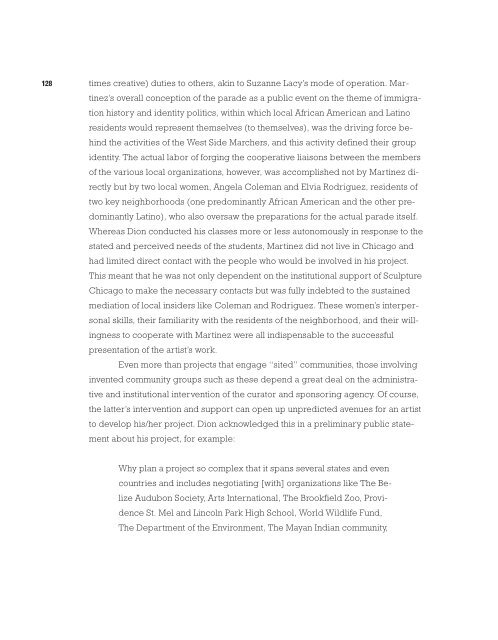ONE PLACE AFTER ANOTHER - Monoskop
ONE PLACE AFTER ANOTHER - Monoskop
ONE PLACE AFTER ANOTHER - Monoskop
You also want an ePaper? Increase the reach of your titles
YUMPU automatically turns print PDFs into web optimized ePapers that Google loves.
128 times creative) duties to others, akin to Suzanne Lacy’s mode of operation. Mar-<br />
tinez’s overall conception of the parade as a public event on the theme of immigra-<br />
tion history and identity politics, within which local African American and Latino<br />
residents would represent themselves (to themselves), was the driving force behind<br />
the activities of the West Side Marchers, and this activity defined their group<br />
identity. The actual labor of forging the cooperative liaisons between the members<br />
of the various local organizations, however, was accomplished not by Martinez directly<br />
but by two local women, Angela Coleman and Elvia Rodriguez, residents of<br />
two key neighborhoods (one predominantly African American and the other predominantly<br />
Latino), who also oversaw the preparations for the actual parade itself.<br />
Whereas Dion conducted his classes more or less autonomously in response to the<br />
stated and perceived needs of the students, Martinez did not live in Chicago and<br />
had limited direct contact with the people who would be involved in his project.<br />
This meant that he was not only dependent on the institutional support of Sculpture<br />
Chicago to make the necessary contacts but was fully indebted to the sustained<br />
mediation of local insiders like Coleman and Rodriguez. These women’s interpersonal<br />
skills, their familiarity with the residents of the neighborhood, and their willingness<br />
to cooperate with Martinez were all indispensable to the successful<br />
presentation of the artist’s work.<br />
Even more than projects that engage “sited” communities, those involving<br />
invented community groups such as these depend a great deal on the administrative<br />
and institutional intervention of the curator and sponsoring agency. Of course,<br />
the latter’s intervention and support can open up unpredicted avenues for an artist<br />
to develop his/her project. Dion acknowledged this in a preliminary public statement<br />
about his project, for example:<br />
Why plan a project so complex that it spans several states and even<br />
countries and includes negotiating [with] organizations like The Belize<br />
Audubon Society, Arts International, The Brookfield Zoo, Providence<br />
St. Mel and Lincoln Park High School, World Wildlife Fund,<br />
The Department of the Environment, The Mayan Indian community,

















